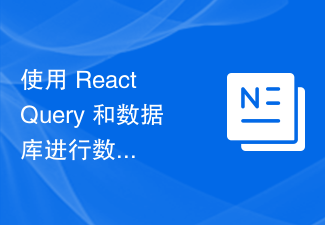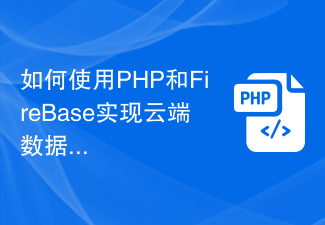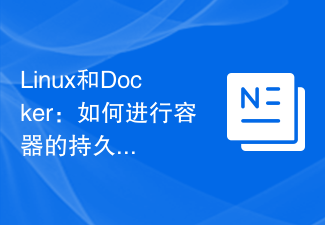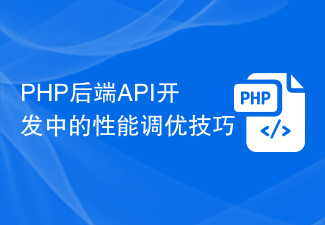 Backend Development
Backend Development PHP Tutorial
PHP Tutorial How to deal with persistence and data management in PHP backend API development
How to deal with persistence and data management in PHP backend API developmentHow to handle persistence and data management in PHP back-end API development
With the continuous development of Internet technology, the demand for Web applications is getting higher and higher. Compared with the previous static websites, dynamic websites require There are more and more back-end development resources and they are becoming more and more mature. Data management and persistence are one of the cores of back-end development.
In PHP back-end development, dealing with data management and persistence is a crucial issue. This article will use this as the main content to introduce in detail how to handle the storage and management of data reasonably, and how PHP code obtains data and changes data through these mechanisms. We will elaborate on it from the following three aspects:
1. Database management
We know that the database is a mechanism for storing large amounts of data. We often use relationships in web applications. type database. In PHP, many database operations are completed through database extensions or frameworks, such as PDO and MySQLi extensions. These extensions provide corresponding APIs to handle database operations such as connections, queries, and transactions, making it easier for PHP code to interact with the database.
When using any kind of database, we must ensure that the database has been installed and configured normally. In addition, we need to archive the database so that the data can be restored in the event of a database failure. We can also decouple the database from the server so it can be shared between multiple applications.
2. Persistence
Persistence refers to storing data on disk so that the data can be retained after the program is closed or the computer is restarted. In PHP, we can use a variety of technologies to achieve persistence, such as files, databases, memory objects, etc.
The method of using files to achieve persistence is very simple, just write the data to the file. However, the file system does not support high concurrency and distributed operations, so it is not suitable for large-scale web applications.
Database persistence requires us to use a database to store data. This method supports high concurrency and also provides mechanisms such as transactions and locking.
Memory object persistence stores data in memory, which is easy to read and modify, but is not suitable for saving long-term data.
When choosing a persistence method, you should choose it based on business needs.
3. Data management
Data management refers to operations such as reading, modifying, and deleting data in the database, including all database operations. Data management can be achieved by using an ORM (Object Relational Mapping) framework. The ORM framework provides a unified programming interface that maps database tables into object-oriented classes. Programmers can use these classes to read and modify the database.
The advantage of the ORM framework is that it can simplify the writing of SQL statements and optimize SQL queries.
In PHP, commonly used ORM frameworks include Doctrine, Eloquent, etc.
When conducting data management, we also need to pay attention to data validity and security. We must ensure that input parameters do not contain malicious content, use data validation mechanisms to ensure data validity, and use encryption mechanisms to ensure data security.
Conclusion
When developing PHP back-end API, dealing with persistence and data management is an essential part. We should rationally select technologies such as databases, persistence methods, and ORM frameworks based on business needs to ensure the efficiency, security, and reliability of data management. At the same time, we should also pay attention to data validity and security to ensure that our applications are not maliciously attacked.
The above is the detailed content of How to deal with persistence and data management in PHP backend API development. For more information, please follow other related articles on the PHP Chinese website!
 PHP中的数据备份May 24, 2023 am 08:01 AM
PHP中的数据备份May 24, 2023 am 08:01 AM在进行Web开发的过程中,数据的存储和备份无疑是非常重要的一环。面对万一出现的数据丢失或恢复需要,备份是非常必要的。对于PHP这种开源的后端语言,数据的备份同样也有许多可选的方案,下面我们就来详细了解一下PHP中的数据备份。一、数据库备份1.1MYSQLdump工具MYSQLdump是一个备份MYSQL数据库的命令行工具,它通过执行SQL语句将整个数据库或
 使用 React Query 和数据库进行数据管理:最佳实践指南Sep 27, 2023 pm 04:13 PM
使用 React Query 和数据库进行数据管理:最佳实践指南Sep 27, 2023 pm 04:13 PM使用ReactQuery和数据库进行数据管理:最佳实践指南引言:在现代的前端开发中,管理数据是一个非常重要的任务。随着用户对高性能和稳定性的需求不断增加,我们需要考虑如何更好地组织和管理应用的数据。ReactQuery是一个功能强大且易于使用的数据管理工具,它提供了一种简单而灵活的方式来处理数据的获取、更新和缓存。本文将介绍如何使用ReactQ
 如何使用PHP和FireBase实现云端数据管理Jun 25, 2023 pm 08:48 PM
如何使用PHP和FireBase实现云端数据管理Jun 25, 2023 pm 08:48 PM随着互联网的快速发展,云端数据管理已成为越来越多企业和个人的必备工具。而PHP和Firebase无疑是两个非常强大的工具,可以帮助我们实现云端数据管理。接下来,本文将会介绍如何使用PHP和Firebase实现云端数据管理。什么是FirebaseFirebase是一个由Google提供的云服务平台,旨在帮助开发人员快速构建出高质量、高可靠性的Web应用程序。F
 Linux和Docker:如何进行容器的持久化存储和数据管理?Jul 29, 2023 am 11:49 AM
Linux和Docker:如何进行容器的持久化存储和数据管理?Jul 29, 2023 am 11:49 AMLinux和Docker:如何进行容器的持久化存储和数据管理?在容器化技术的应用中,容器的持久化存储和数据管理是非常重要的一环。本文将介绍如何在Linux和Docker中实现容器的持久化存储,并提供相应的代码示例。一、Docker中的容器持久化存储在Docker中,容器是通过镜像来创建的,而镜像本身是只读的。因此,当容器被删除后,其内部的数据也会随之丢失。为
 PHP后端API开发中的性能调优技巧Jun 17, 2023 am 09:16 AM
PHP后端API开发中的性能调优技巧Jun 17, 2023 am 09:16 AM随着互联网的快速发展,越来越多的应用程序采用了Web架构,而PHP作为一种广泛应用于Web开发中的脚本语言,也日益受到了广泛的关注与应用。随着业务的不断发展与扩展,PHPWeb应用程序的性能问题也逐渐暴露出来,如何进行性能调优已成为PHPWeb开发人员不得不面临的一项重要挑战。接下来,本文将介绍PHP后端API开发中的性能调优技巧,帮助PHP开发人员更好
 有效防止Localstorage数据丢失的方法Jan 13, 2024 am 10:25 AM
有效防止Localstorage数据丢失的方法Jan 13, 2024 am 10:25 AM如何避免Localstorage数据丢失?随着Web应用程序的发展,数据的持久化成为了一个重要的问题。而Localstorage是一种非常常用的浏览器提供的数据持久化方案。但是,由于各种原因,LocalStorage中存储的数据有可能会丢失。本文将介绍几种避免LocalStorage数据丢失的方法,并提供具体的代码示例。一、定期备份数据定期备份数据是避免Lo
 PHP API开发中的最佳跨域策略和实现Jun 17, 2023 am 11:07 AM
PHP API开发中的最佳跨域策略和实现Jun 17, 2023 am 11:07 AMPHPAPI开发中的最佳跨域策略和实现随着RESTfulAPI的兴起,作为后端开发语言的PHP也在众多Web应用中得到了广泛的应用。在开发RESTfulAPI时,往往需要考虑到跨域访问的问题。本文将讨论PHPAPI开发中最佳的跨域策略及如何实现。跨域(Cross-OriginResourceSharing)指的是一个域下的文档或脚本试图去请求另一
 Vue项目中如何进行数据的本地存储和管理Oct 08, 2023 pm 12:05 PM
Vue项目中如何进行数据的本地存储和管理Oct 08, 2023 pm 12:05 PMVue项目中数据的本地存储和管理是非常重要的,可以使用浏览器提供的本地存储API来实现数据的持久化存储。本文将介绍如何在Vue项目中使用localStorage来进行数据的本地存储和管理,并提供具体的代码示例。初始化数据在Vue项目中,首先需要初始化需要进行本地存储的数据。可以在Vue组件的data选项中定义初始数据,并通过created钩子函数来检查是否已


Hot AI Tools

Undresser.AI Undress
AI-powered app for creating realistic nude photos

AI Clothes Remover
Online AI tool for removing clothes from photos.

Undress AI Tool
Undress images for free

Clothoff.io
AI clothes remover

AI Hentai Generator
Generate AI Hentai for free.

Hot Article

Hot Tools

Dreamweaver CS6
Visual web development tools

Notepad++7.3.1
Easy-to-use and free code editor

Safe Exam Browser
Safe Exam Browser is a secure browser environment for taking online exams securely. This software turns any computer into a secure workstation. It controls access to any utility and prevents students from using unauthorized resources.

SublimeText3 English version
Recommended: Win version, supports code prompts!

ZendStudio 13.5.1 Mac
Powerful PHP integrated development environment




